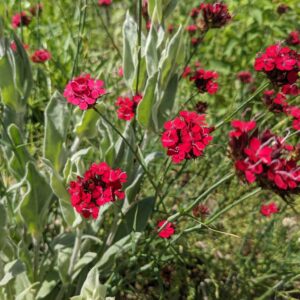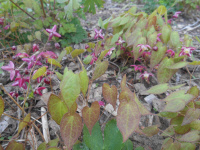Drought, Xeric & Dry Soil Plants
Showing 33–40 of 126 results
-
Dianthus cruentus Blood pink Z 5-9
Small but eye-catching carmine flowers held high on a leafless stem above basal foliage. Blooms in late spring-early summer
Small but eye-catching carmine flowers held high on a leafless stem above basal foliage. Blooms in late spring-early summer
Size: 2-3’ x 6-9”
Care: sun in moist well-drained soil
Native: Balkans
Wildlife Value: Attracts bees & butterfliesFirst described in Spic. Fl. Rumel. 1: 186 1843.
-
Dianthus deltoides Maiden pink Z 3-9
May - June and longer if deadhead bright pink or white
May – June and longer if deadhead, bright pink or white
Size: 8”x 12”
Care: Full sun well-drained soil, slightly alkaline
Native: Scotland to Norway
Awards: England’s Royal Horticultural Society Award of MeritDeltoides refers to the inverted V-shaped pocket at the base of the petals. D. deltoides 1st identified in 1671 by Swiss botanist Gaspard Bauhin (1560-1624) in Pinax theatri botanici, a landmark of botany, describing and classifying some 6,000 plants.
-
Dianthus pinifolius Pineleaf garden pink Z 4-9
Crimson clusters on wiry stems high above narrow-leaved, glaucous foliage, blooming in late spring to early summer
Crimson clusters on wiry stems high above narrow-leaved, galucious foliage, blooming in late spring to early summer
Size: 12” x 6”
Care: sun in moist well-drained to well-drained soil
Native: Balkan Peninsula & RomaniaDescribed before 1796.
-
Dictamnus fraxinella syn. D. alba Gas plant, Burning bush Z 3-9
Magestic white or pink spikes of flowers in early summer, glossy, lemon-scented leaves
Magestic white or pink spikes of flowers in early summer, glossy, lemon scented leaves.
OUT OF STOCK
Size: 2-3' x 2' slow growing
Care: full sun to part shade in well-drained soil.
Native: Europe
Wildlife Value: Host for Giant Swallowtail caterpillars. Rabbit & deer resistant.
Awards: England’s Royal Horticultural Society Award of Merit.Dictamnus is from the mountain Dicte, located in Crete. Popular Elizabethan cottage garden plant since the late 1500’s. English herbalist John Gerard (1545-1612) called it “gallant.” Grown in the Eichstätt Garden, the garden of Johann Konrad von Gemmingen, prince bishop of Eichstätt in Bavaria, c. 1600. Grown by Jefferson at Monticello in the “center of the NW shrub circle,”1807. The roots used medicinally “resisting purification and poison.” Gardeners’ Dictionary, 1768. Once established very long-lived plant, “known to stand on the same place for fifty years still bearing healthy blooms.” The Garden Feb 19, 1876.
-
Diervilla lonicera Northern bush honeysuckle Z 3-7
Lemon yellow flowers on this short shrub June to August. In fall its foliage turns dark red for the final fireworks’ display. Great shrub for tough, dry shady areas.
Lemon yellow flowers on this short shrub June to August. In fall its foliage turns dark red for the final fireworks’ display.
Size: 3’ x 3’ spreading
Care: sun to part shade in well-drained soil, drought tolerant
Native: Eastern half of US & Canada, Wisconsin native.
Wildlife Value: nectar source for Bumblebees. Birds make nests from the branches and eat the fruitsUsed medicinally by numerous Native Americans – Algonquin, Chippewa, Cree, Iroquois, Menominee, Meskwaki, Ojibwa and Potawatomi. Used as remedy for sore eyes, diuretic, “old men who cannot retain urine,” constipation, stomach pain, increase breast milk, to “spoiled babies with adulterous mother,” STD’s and vertigo. Dr. N. Dierville, a surgeon, carried this to France from Canada (then Acadia) in 1699. Botanist to France’s king, Louis XIV, Joseph Pitton de Tournefort (1656-1708) named this to honor Dierville
**LISTED AS OUT OF STOCK BECAUSE WE DO NOT SHIP THIS ITEM. IT IS AVAILABLE FOR PURCHASE AT OUR RETAIL LOCATION.
-
Dryas drummondii Drummond’s mountain avens, Yellow mountain avens Z 3-9
Mat of leathery, wrinkled, creeping foliage, glossy green turning bronze in fall, oval with rounded teeth. From May through July leafless, erect flower stems rise 4-8” above the ground-hugging leaves, with nodding 8 to 10 buttercup yellow petals emerging from a fuzzy, decorative cup.
OUT OF STOCK
Mat of leathery, wrinkled, creeping foliage, glossy green turning bronze in fall, oval with rounded teeth. From May through July leafless, erect flower stems rise 4-8” above the ground-hugging leaves, with nodding 8 to 10 buttercup yellow petals emerging from a fuzzy, decorative cup.
Size: 6-10” x 12-24”
Care: sun in well-drained soil. Drought tolerant
Native: Alaska south to Washington east to Montana, most of Canada1st collected in seed by Sir John Richardson (1787-1865) Scottish naturalist on Franklin’s 1st overland expedition to the Arctic coast, 1819-1822. Franklin called the expedition “disastrous” but went again. Both Richardson and Thomas Drummond (1793-1835) collected this in seed and flower on Franklin’s 2nd overland expedition to the Arctic coast. (1825-1826) It is named to honor Thomas Drummond at Richardson’s request. Curtis’s Botanical Magazine v. 57 ser. 2 (1830). Richardson then led a 3rd expedition searching for Franklin’s last Arctic expedition, finding no trace of the lost ships or men.
-
Echinops ritro Globe thistle Z 3-9
Mid to late summer, round, steel blue flower heads at 1st prickly then turning soft and fuzzy.
Mid to late summer, round, steel blue flower heads at 1st prickly then turning soft and fuzzy.
Size: 3-4' x 18"
Care: Sun in well-drained soil, drought tolerant
Native: Southern Europe
Wildlife Value: attracts American painted lady butterflies, deer resistantThe name Echinops is Greek meaning “like a hedgehog” describing the circular spiny thistles. Introduced to England by 1570. Popular Victorian flower. Cultivated by Washington at Mount Vernon.
-
Epimedium x rubrum syn. Epimedium alpinum var. rubrum Red barrenwort Z 4-8
In mid- spring small, star-shaped, rosy-red flowers dance on the ends of wiry-thin stems about one foot high. Red-flushed foliage follows the flowers, the more sun, the more red leaves. Wonderful groundcover especially in shady, well-drained soil where little else grows.
OUT OF STOCK
In mid- spring small, star-shaped, rosy-red flowers dance on the ends of wiry-thin stems about one foot high. Red-flushed foliage follows the flowers, the more sun, the more red leaves. Wonderful groundcover especially in shady, well-drained soil where little else grows.
Size: 16” x 24” slow spreading
Care: Sun to shade in most any soil but best in part shade – one of most adaptable plants
Awards: Elisabeth Carey Miller Botanic Garden Great Plant PickCross between Epimedium grandiflorum and Epimedium alpinum. 1st described in 1853 in Belgique Hort. iii. 33. I.







